
OUR VERDICT
Gigabyte’s new Aero 15 adds a hecta-core cpu, a 144Hz FHD screen and a faster SD card reader to its winning formula. As a professional ultraportable that games, the Aero 15 is hard to beat.
FOR
- big, fast screen
- 5mm thin bezels
- full-sized keyboard
- 14-inch form factor
AGAINST
- Webcam below screen
- Keyboard can feel cramped
Gigabyte’s Aero range has always attempted to bring premium gaming components to the Ultrabook form factor, and this newly-refreshed Aero 15 is no different. Bringing together a 15.6-inch Pantone color certified screen, full-sized keyboard with number pad, dedicated Nvidia GPU and a generous 94Wh Li-Ion battery and squeezing it all into a tiny 14 x 9.8 x 0.7-inch (35.6 x 25 x 1.9 cm) form factor is an impressive feat of engineering. Combine this with one of Intel’s new high-end 8th-generation mobile CPUs, 16GB o f DDR4 RAM and a 512GB SSD and you have a cutting edge gaming PC that slyly takes the shape of a professional Ultrabook – and when it comes to performance, this machine is far more than just hot Aero.
Pushing the envelope this far has invariably lead to some design choices that will be divisive – like dropping the web camera to the bottom of the screen, and giving the keyboard a fractionally off-center and crowded feel. On the whole though, these compromises seem to have been carefully considered and ultimately end up as minor grievances rather than major caveats.

Price and Availability
While it might look like a lightweight Ultrabook that’s intended for lighter workloads, the Aero 15 actually packs a number of powerful components into its small chassis that mean it can tackle more than most 14-inchers. Squeezing these expensive parts into such a small form factor adds additional spatial and thermal engineering costs to an already expensive spec sheet.
While this combination can often lead to a lofty price point at retail, fortunately the Aero manages to keep it’s price reasonable, with options starting at $1,999 (£1,999, AU$2,899). That price will get you the Nvidia GeForce GTX 1060 GPU configuration, but you can optionally step up to a significantly more efficient GTX 1070 Max-Q GPU for only a few hundred dollars extra at $2,299 (£2,199, AU$3299). Then, you’ve also got the option to give the screen a 4K facelift and reinstate the NVMe SSD for a total of $2,399 (£2,199 AU$3699).
These new 8th-gen devices will be available from stores and online retailers on the 16th of April. Some retailers will reportedly be offering pre-orders before then.
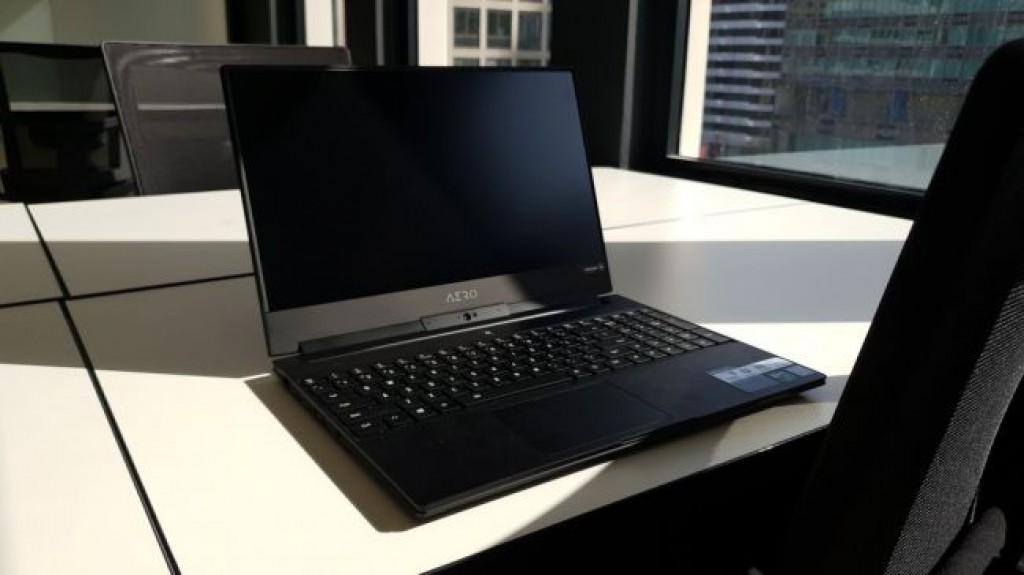
Design
The design aesthetic of the Aero 15 is largely governed by the fact that its 15.6-inch screen has been packed into a 14-inch laptop body. While that’ll make it appealing to anyone for a small and portable laptop, it does create some hurdles that you’ll have to be willing to overlook. Take the display for example: on the one hand, it’s amazing that you can have a screen almost without borders, but those 5mm bezels force the rest of the computer to have comparatively sharper and squarer corners than the friendlier, rounder corners that are generally in vogue these days.
The reduced bezel size also means there’s no space for the webcam at the top of the screen, forcing it to drop to bottom near the the hinge, something that isn’t ideal in terms of function (we’ll discuss this more later), but also makes the bottom bezel bulkier than it arguably needs to be, and which throws off the balance of the screen design overall. It’s good to see a gaming laptop range experimenting with screen layout and there will be plenty willing to sacrifice an unused webcam for thinner bezels and a smaller overall footprint, but it’s an element that will undoubtedly turn some users away as well.
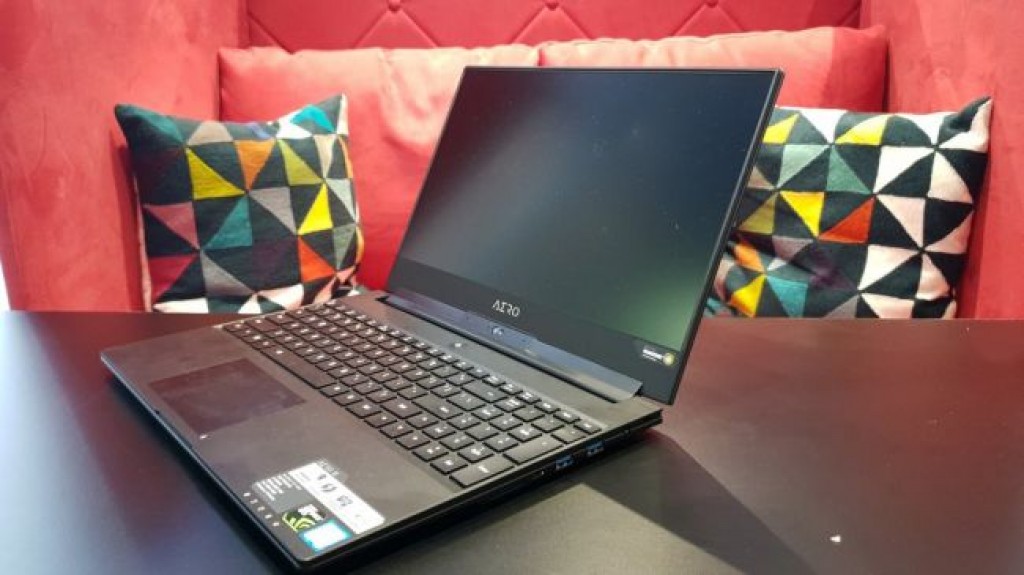
While we’re pleased that the Aero 15’s keyboard includes a number pad – it’s a feature that’s critical for certain professionals – it does suffer from some of the same space constraints as the screen, with the keys filling the frame and sitting just a hairline away from the body edge. Obviously, with that limited space there’s no gap between the keyboard proper and the number pad and the two have been melded together in a way that abbreviates the right Shift key, and gives you little room for error on the Backspace and Enter keys. It’s not a big enough grievance to be a deal breaker, you’ll adapt to the altered layout soon enough, but is is something that’ll likely irk initially.
It’s worth looking at the Aero 15 design from a broader perspective, however, as there aren’t any other laptop vendors that’ll give you a gaming-grade machine with a 15-inch screen and a full number pad in a 0.7 inch (1.8cm) thick chassis – something that allows it to fit into just many 13-inch laptop backpacks or shoulder bags.
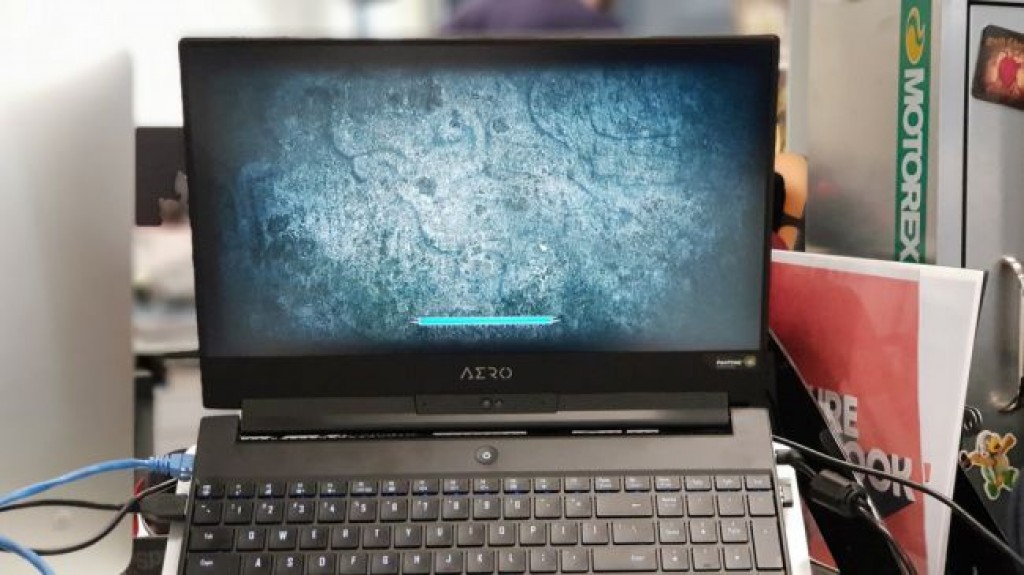
And while the unit is on the heavy side at a little over 4.4 pounds (2kg), for something with this much power and battery life, it’s actually exceptionally lightweight. It doesn’t skimp on materials either, reintroducing the carbon fibre envelope-shaped embellishment to the top of the Aero 15’s premium metallic shell. That appeal flows into the silky smooth trackpad that’s one of the most responsive we’ve tested in recent memory. Moreover, although the keyboard is a little constrained on the right hand side, it is otherwise comprised of pleasant feeling keys with powdery matte keycaps and deep travel distances for a painless typing experience.
Turning to the internal design, the Aero 15 uses an integrated dual fan cooling system with two heat pipes thermally servicing both the CPU and GPU to distribute heat effectively when one is hotter than the other. The inlet fan grills have been placed on the undercarriage, allowing the unit to save precious edge space for additional ports. The output vents are hidden under the hinge and throw heat up onto and behind the screen of the device, which seems to keep the underside cool enough to use on your lap if you wanted to – something that’s not always the case in gaming-capable laptops. This thermal design is effective at keeping both the CPU and GPU under 91ºC and 83ºC (196ºF and 182ºF) respectively, even when pushed hard in gaming and CPU heavy benchmarks.
Screen and ports

Taking prime position at the top of the Aero 15, the screen looks good in it’s near bezel-less frame. While the entry-level configuration we tested for this review was only an IPS LCD at 1920 x 1080-pixel resolution, it’s upped the refresh rate from 60Hz to 144Hz and it still has that unique Pantone color calibration. That 144Hz refresh rate means this is a super speedy screen that’ll appeal to anyone playing first person shooters (especially online) and delivers smooth motion and better responsiveness, and for the more professional-minded the color calibration means it’ll work well as a design tool.
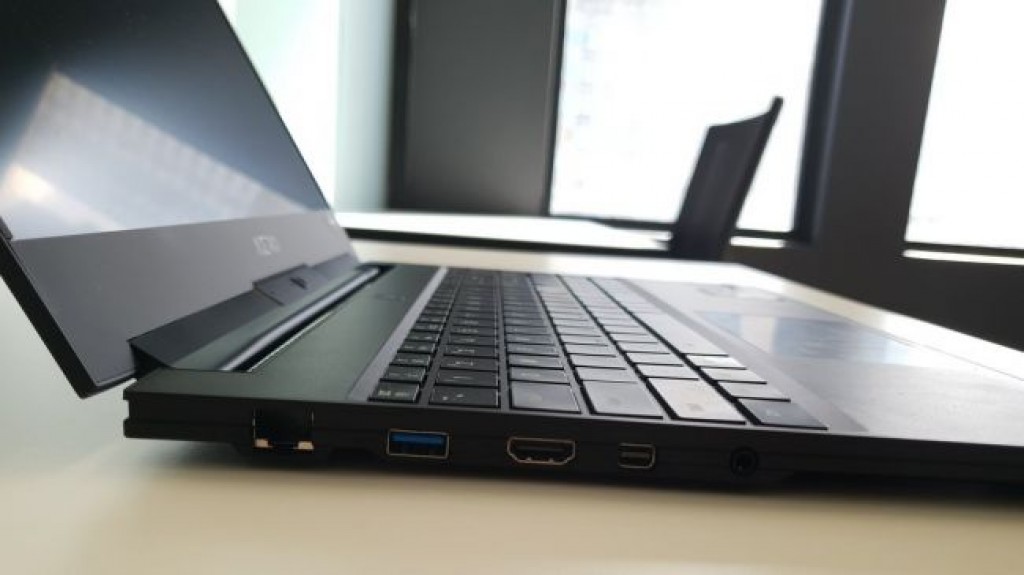
You could argue that a 4K screen would be more useful to the latter group than having the faster refresh rate, but you can upgrade this screen to 4K if you’re willing to spend a bit extra and if you’re equally interested in gaming, 1080p is a good middle-ground option. In other words, 4K seems like a sensible optional extra. From a gamer’s perspective, the only other thing you’re really missing on both the FHD and the 4K displays is G-Sync compatibility. Gigabyte told us that’s a conscious design decision in favour of better battery life – the Aero’s ability to completely switch off the Nvidia GPU when its not in use means that the latter’s video signal must always be passed through the integrated Intel HD 620 GPU and that, sadly, means no G-Sync capabilities. This is as much a laptop for designers as gamers though, so that’s a trade-off we feel is worth the cost – especially when you see how good this one’s real-world battery life actually is.
Adding to that the long list of positives is one of the most comprehensive sets of input and output ports we’ve seen on an ultraportable in a long time, meaning you can basically knock 50 – $150 off the price for the dongle or dock you now need to build with many Ultrabooks. Not only do you get full-sized HDMI 2.0, two Type-A USB 3.1 Gen 1, a Type-A USB 3.1 Gen 2, Ethernet and 3.5mm Audio Combo connection, but you also get a high speed UHS-II 500MB/s SD Card slot (great for transferring or working on 4K video), a Thunderbolt 3 USB Type-C port and an additional mini-DisplayPort 1.4.
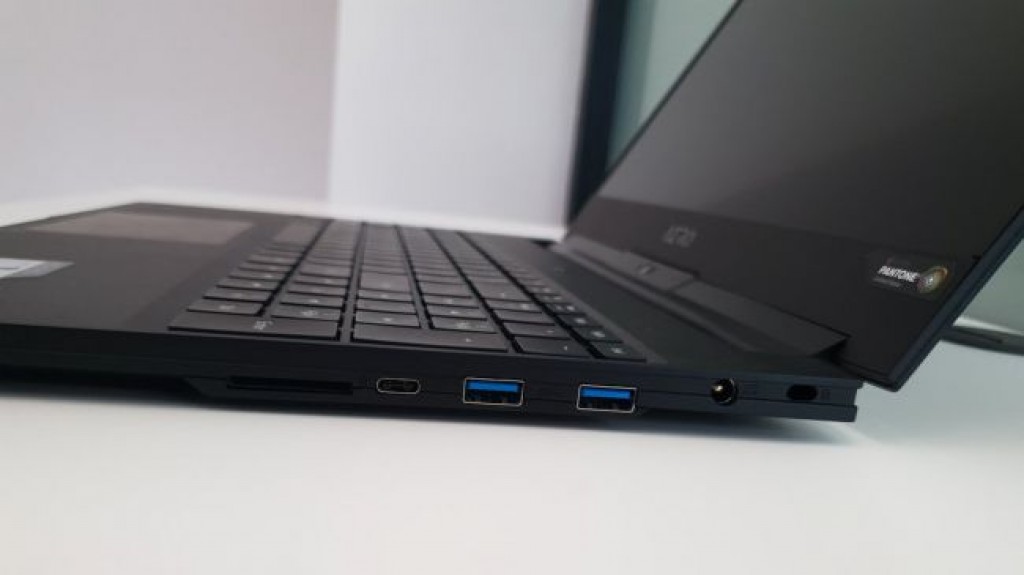
Performance
Packing the first six-core mobile CPU from Intel – one of the company’s new high-end 8th-gen Core i chips – the Gigabyte Aero 15 cut a swathe through our CPU-intensive benchmarks. Take the raw CPU scores from Cinebench’s R15 benchmark and you’ll see that, on single-core tests, this laptop’s new Core i7-8750H CPU scores only a little better than its i7-7700HQ predecessor on the ASUS ROG Zephyrus, with Gigabyte getting 156 to the ASUS’s score of 149. This 5% per-core boost translates into a 17.4% overall boost in multi-threaded CPU benchmarks when using Windows’ ‘Balanced’ power mode.
What’s more interesting is that this can be pushed considerably further by putting the Aero 15 into Performance mode, which pushes that multi-threaded score from 861 all the way up to 1125 – a considerable boost that puts it 53.5% ahead of the ASUS and fairly close to desktop performance levels. Backing this up is a GeekBench multi-core score of 17,171 which puts it 12.6% ahead of TechRadar’s leading Ultrabook, the Dell XPS 13.
In general work and home tasks, the Aero achieves similarly impressive results in getting 4460 and 5635 in the respective Home (accelerated) and Work (accelerated) PCMark 8 benchmarks, which means it powers through tasks better than any previous laptop we’ve tested with 16GB of RAM to date.

While the Aero 15 has generous GPU power for a professional ultra-portable, the mid-level Nvidia GeForce GTX 1060 model is middle of the road when it comes to performance against today’s gaming laptops. It’ll get close to, if not more than 60fps, on most early-2017 games using Ultra settings at 1080p resolution. There are exceptions: it manages to only get an average of 35 fps on Ghost Recon Wildlands at 1080p/Ultra, for example. Turn down those graphical settings a little however, or play slightly older titles, and you’ll be able to really put that 144Hz screen to use, with less-demanding titles often pumping out 100-plus frames per second. The Aero’s GTX 1060 more than holds its own as a genuine gaming GPU that’ll handle anything you throw at it, as long as you don’t need to have every graphical bell and whistle turned up to the max. If you’re looking to really push the gaming side of things, then upgrading to the GTX 1070 model is an appealing proposition. Moving up to a 4K display will require a sacrifice in graphical settings (or slower frame rates) if you want to run games at the screen’s native resolution. We didn’t get a chance to test the higher-end model this time around, but for a bit of context, last year’s Max-Q GTX 1070 Aero 15X did score 33% higher than this GTX 1060 model on 3DMark’s Firestrike Extreme benchmark. 3DMark tests don’t always translate perfectly into real world game boosts – the difference can at times be much bigger or much smaller depending on the game – but it’s not a bad indication of the general performance boost you’ll get when you average them all out.
Conclusion
Gigabyte’s initial Aero 15 broke a lot of new ground in its pursuit of squeezing a full-featured 15-inch professional laptop into a 14-inch thin-and-light form factor, and this year’s upgrade has managed to improve on the original design in a few key areas. Packing one of Intel’s new 8th-gen high-end mobile CPUs means the Areo 15 is able to harness considerable performance boosts, making this a beast of a machine for anyone who’s encoding video, working with big images or otherwise doing intensive multimedia work. Add to this a jump from a 60Hz screen to the faster 144Hz spec and incorporating a speedier UHS-II SD Card reader – features which’ll appeal to the gaming and creative professional camps respectively – and you have a very-respectable annual upgrade. But Gigabyte has also done some work optimising the battery life, allowing it to get over 7 hours of movie playback when in Performance mode, a result that should translate to nearly a full working day of general usage, even when you mix in some time with the aforementioned multimedia tasks.
Gigabyte has toned down the chassis design on this year’s Areo 15 by culling the zesty orange and green color offerings, and while we’re a little sorry to see those louder variations go, it’s a decision that makes sense for the professional market tier. However, there’s one omissions from the new entry-level unit that is a genuine trade-off from the previous models, and that’s the switch from an NVMe SSD capable of speedy 3000 and 1500MB/s read/write speeds (respectively) to a SATA 3 SSD in the current model, which only gets around 500MB/s for read and writes. While this doesn’t affect the more expensive models (which still have those NVMe SSDs) and perhaps isn’t a deal breaker on it’s own, if you are doing particularly disk-intensive activities you may want to consider passing on the cheapest Aero 15 model.
All up then, there’s a lot to like about this updated Gigabyte Aero 15 and if you don’t mind the unusual webcam placement and square design then there’s really nothing that should bother you about this laptop in the long term. The six-core mobile Core i7 CPU, 16GB RAM allocation and dedicated GeForce GTX 1060 GPU all make the Aero 15 a powerful professional offering in an exceptionally compact package. With generous battery life and a more-than-adequate capacity for gaming, this is a solid laptop choice for the performance focused professional, or anyone looking for a slim and light that also packs a decent punch.
Source: techradar.com









































